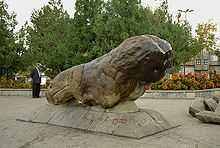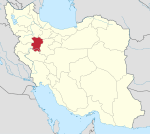Hamedan Stone Lion
The stone lion of Hamedan (Persian: شیر سنگی همدان šir-e sangi-ye hamedân) is a historical monument in Hamedan, Iran.
The stone lion -one part of the 'Lions Gate'- sits on a hill where a Parthian era cemetery is said to have been located.
When first built, this statue had a twin counterpart for which they both constituted the old gate of the city. During the Islamic conquest of Persia, the victorious Arabs referred to the gate as bâb ul-asad (Persian: بابالاسد, "the lions gate").

The gates were demolished in 931CE as the Deylamids took over the city.
Mardāvij unsuccessfully tried transporting one of the lions to Ray. Angered by the failure to move them, he ordered them to be demolished. One lion was completely destroyed, while the other had its arm broken and pulled to the ground. The half demolished lion lay on its side on the ground until 1949, when it was raised again, using a supplemental arm that was built into it.
Iran's Cultural Heritage Organization reports that the lions were first thought to have been built by the orders of Alexander the Great to commemorate the death of his close companion Hephaestion.[1]
References
- General references
- Simaye Miras-i Farhangi-i Hamedan, Iran Cultural Heritage Organization, ISBN 964-7483-68-6, 2003
- Fox, R. L. Alexander the Great (Page Number: 434), Penguin Books, London
| ||||||||||||||||||||||||||||||||||||||||||||||||||||||
